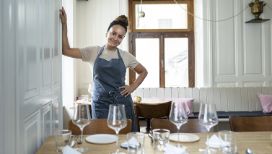Thies Henkel: ex-chef at "Oh de Vie"
Young chefs are always faced with the challenge of developing their own style – something Thies Henkel already achieved at an early age. At the "Oh de Vie" restaurant in the "Lenkerhof" resort, he was able to hone his skills once again. Now the chef has set up his own business.

Thies Henkel’s inspiration from his grandfather
Thies Henkel already harbored the desire to become a chef as a child. "Even as a ten-year-old, I got into the kitchen myself to cook a tomato sauce," says the Rhinelander. He turned to his grandfather for help with cooking, as his parents were very busy at work. "Besides, my mom was never a good cook," says Henkel, who was born in 1991.
Dream job as a chef
More than 20 years after these first attempts at cookery, Henkel can justifiably claim to have become a good chef. Today, his parents can laugh at such statements, even though they were quite critical of his career choice at the time. "My parents would have preferred for me to go into a trade. Today, they are proud of me," says Henkel. By the time he became head chef at "Oh de Vie" in the "Lenkerhof" gourmet spa resort, he "couldn’t imagine doing anything other than being a chef," he says.
Henkel learnt from the best
It was a rocky road. Immediately after his apprenticeship, 16-hour days in a hotel with a Michelin-starred restaurant were the order of the day, but this did not dampen his passion for cooking. Over the course of his career, Henkel had instructors from a wide variety of culinary backgrounds. Among the most influential were German celebrity chef Heinz Winkler and his young colleague Tohru Nakamura, Chef of the Year 2020, with whom Henkel worked as a sous chef in Munich. "I don’t really know what it means when you talk about chefs having their ‘own signature’. But it’s clear that none of my dishes can be found anywhere else in a restaurant," says Henkel. For many young chefs, finding and developing their own style is a major challenge. This is expected, but takes time to develop.
Craftsmanship is the basis, structure the key to success
Henkel himself works very instinctively and can rely on his craft. "That’s the basis for everything, but the key to success is to be well structured. I’m a bit of a slob at home, but I’m very efficient in the kitchen," says Henkel about himself. At his workplace, he appears perfectly organized and determined.
Fine seafood products are highly valued
The result of this combination of good qualities can be seen on the plates: At the "Lenkerhof", for example, these included dishes such as a liquid-pickled and briefly fried red mullet, which the chef served on braised tuna cheeks, combined with an eggplant tapenade, some coconut, pickled eggplant and an eggplant emulsion with basil oil. In general, Henkel attaches great importance to fine seafood products. By marinating the fish in a four percent brine with a little vinegar, the rouget, for example, loses its often somewhat tangy flavor, he says, and frying gives it a crispy skin, after which the fish has to be cooked at a mild temperature of exactly 41 degrees.
Rustic saddle of lamb with raviolo
But fish is not everything, dishes can also be hearty and powerful without losing any of their elegance. Henkel created a rack of lamb with a crispy crust of herbs and tomatoes and two sauces – basil beurre-blanc and lamb jus. This was served with a so-called Carinthian raviolo: a pastry pocket filled with a tomato ragout and braised lamb shoulder, which is then deep-fried. Quite rustic, but full of energy and flavor. "Many guests ask for a second raviolo," says Henkel with a laugh.
Henkel was drawn back to Germany
It’s not just his guests who honor Henkel’s work at the stove, the experts were also impressed: In his very first year at the "Lenkerhof", he started with 14 GaultMillau points. "I set myself really high goals, but I am convinced that I can achieve them," says Henkel. The chef now wants to realize these goals in the small German town of Sprockhövel, where he has taken over the "Tante Anna" restaurant together with his wife. There is no reason to doubt that he will be able to maintain or even improve the high standard of the restaurant.
Would you like to discover more great restaurants? With the Platinum Dining Credit, Platinum Cardholders get a credit to the value of CHF 40 once a quarter if they spend more than CHF 250 at a GaultMillau restaurant that accepts American Express.










